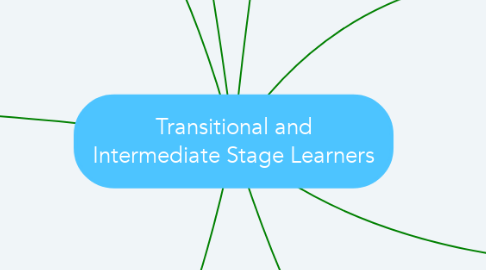Transitional and Intermediate Stage Learners
by Jenny Plumley

1. Intermediate Writing
1.1. Student is using affixes
1.2. Student stamina increases to the ability to work on one piece over a number of days
1.3. Focus turns from spelling to meaning and message/voice
1.4. Students exhibit ability to revise and edit independently
2. Intermediate Reading
2.1. Student is able to read complex nonfiction texts such as textbooks to gain information and read for meaning
2.2. Students look at words as two or more units of sound and meaning
2.3. Students read with greater fluency, especially when reading silently
2.4. Students increase use of reading with expression
3. Intermediate Vocabulary and Spelling
3.1. Students learn new vocabulary through reading in other subjects like math and science
3.2. Vocabulary is still best taught directly and systematically
3.3. Teach students to break down words in order to understand meaning
3.4. morphemic analysis
3.5. Include ambiguous vowels, consonant doubling, affixes, accented/unaccented syllables in spelling instruction and sorts
4. Effectively Teaching Reading, Writing, and Spelling to Intermediate Stage Learners
4.1. Students are manipulating multisyllabic words and focus on word meanings.
4.2. Focused on in this stage are doubling & e-drop with ed and ing, other syllable and affix doubling, long vowel patterns (stressed syllable), r-controlled vowels (stressed syllable), and unstressed syllable vowel patterns.
4.3. Model breaking down words, making meaning with the word, and using the word correctly
4.4. Encourage students to look up new words in dictionaries and record words in a word study journal
4.5. Stress importance of patterns
4.6. Regularly assess student knowledge and usage of words
4.7. Actively engage in writing process with students, model researching, and using unfamiliar words to gain knowledge
5. Transitional Writing
5.1. Becomes more fluent
5.2. Greater complexity
5.3. May struggle with homophones and ambiguous vowels
5.4. Larger bank of sight word knowledge
5.5. Students enter with the ability to use consonants, blends, digraphs, short vowels, and sight words
5.6. Students may often confuse complex consonant units, common inflections, and the change from y to i in some words
6. Transitional Reading
6.1. Instead of sounding out each individual letter, readers sound out chunks
6.2. Can read one syllable words fluently, and multisyllabic words with context clues
6.3. Ability and stamina to read silently increases
6.4. Encourage students to read at least 30 minutes a day
6.5. Provide a variety of texts, including picture, nonfiction, and chapter books
6.6. Developing background knowledge is key to bridge from decoding reading to reading for meaning
7. Transitional Vocabulary and Spelling
7.1. Students learn 10-15 new words a week
7.2. Teacher takes an active role in teaching new vocabulary
7.3. Read-alouds are a good opportunity to introduce new vocabulary
7.4. Model using a rich vocabulary
7.5. Include homophone, homonym, and homograph practice in word sorts, writing, and anchor charts
8. Effectively Teaching Reading, Writing, and Spelling to Transitional Stage Learners
8.1. Focus on long vowels (VCe), r-controlled vowels, other common long vowels, complex consonants, and abstract vowels
8.2. Give students opportunities to "play" with their use of language in journals, quick writes, and responding to readings
8.3. Encourage using already known spelling patterns to build on writing compound and complex word and sentence choices
8.4. Model the writing process with students whole group and small group
8.5. Students use their spelling sorts in their writings


